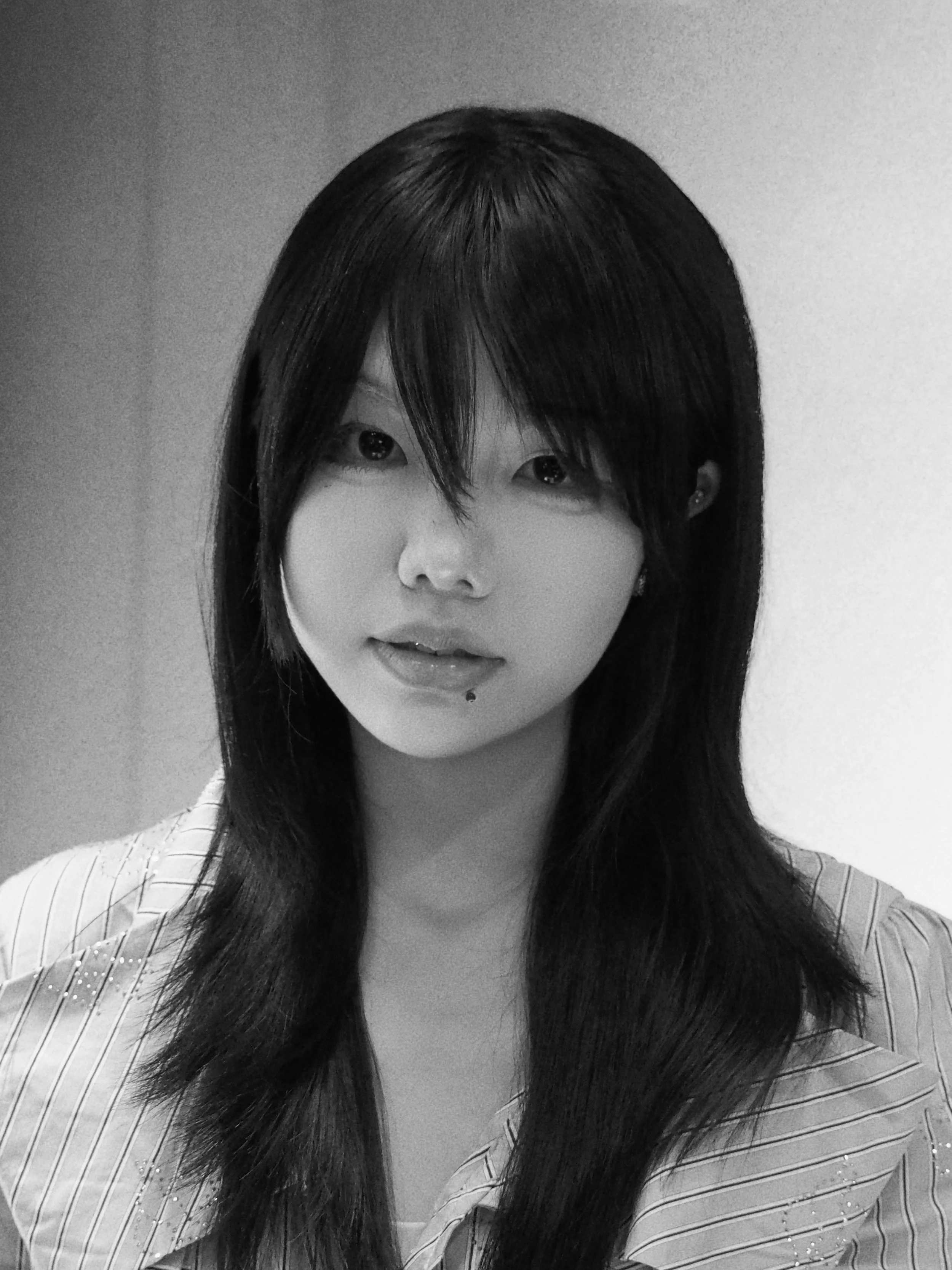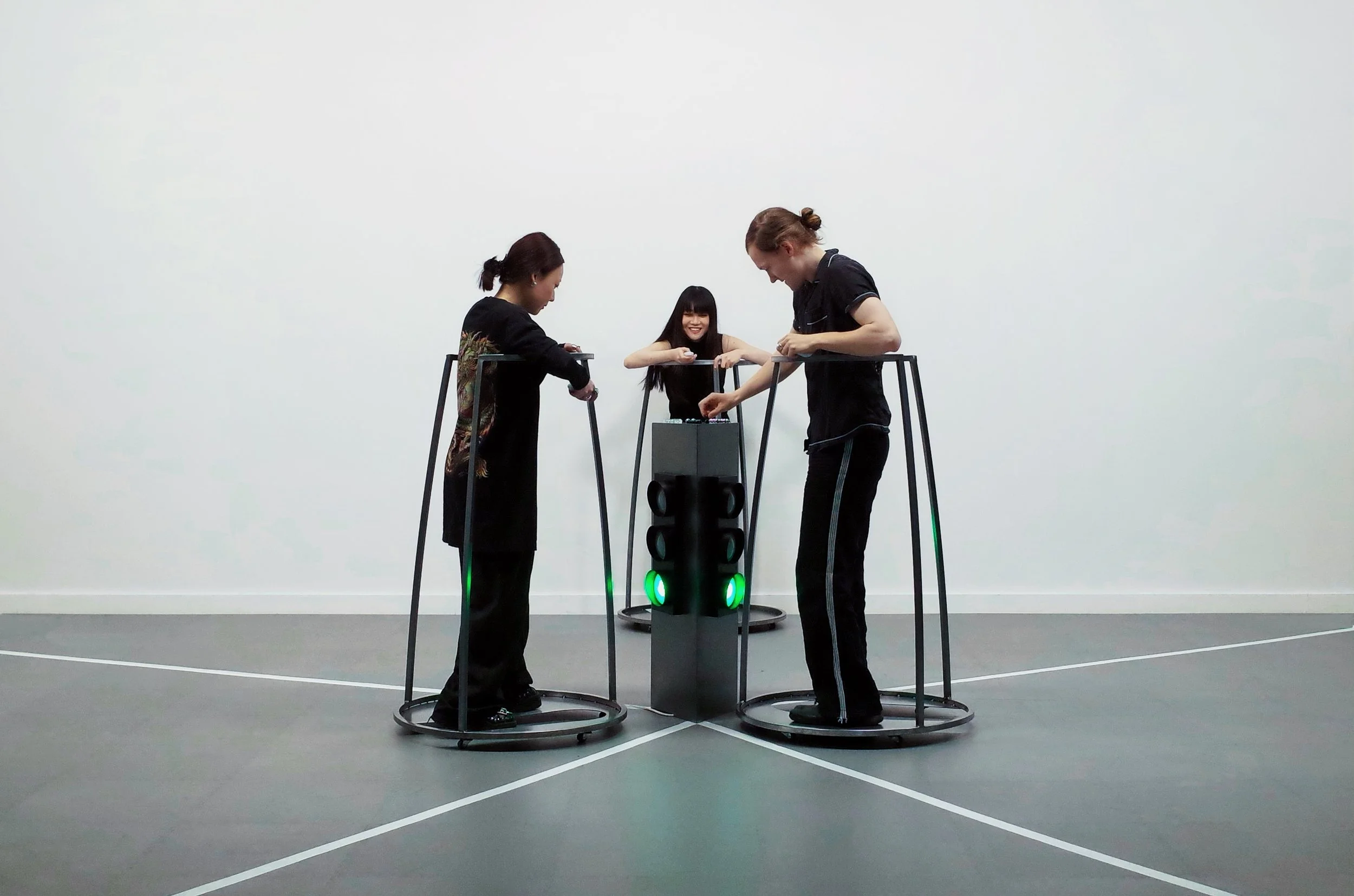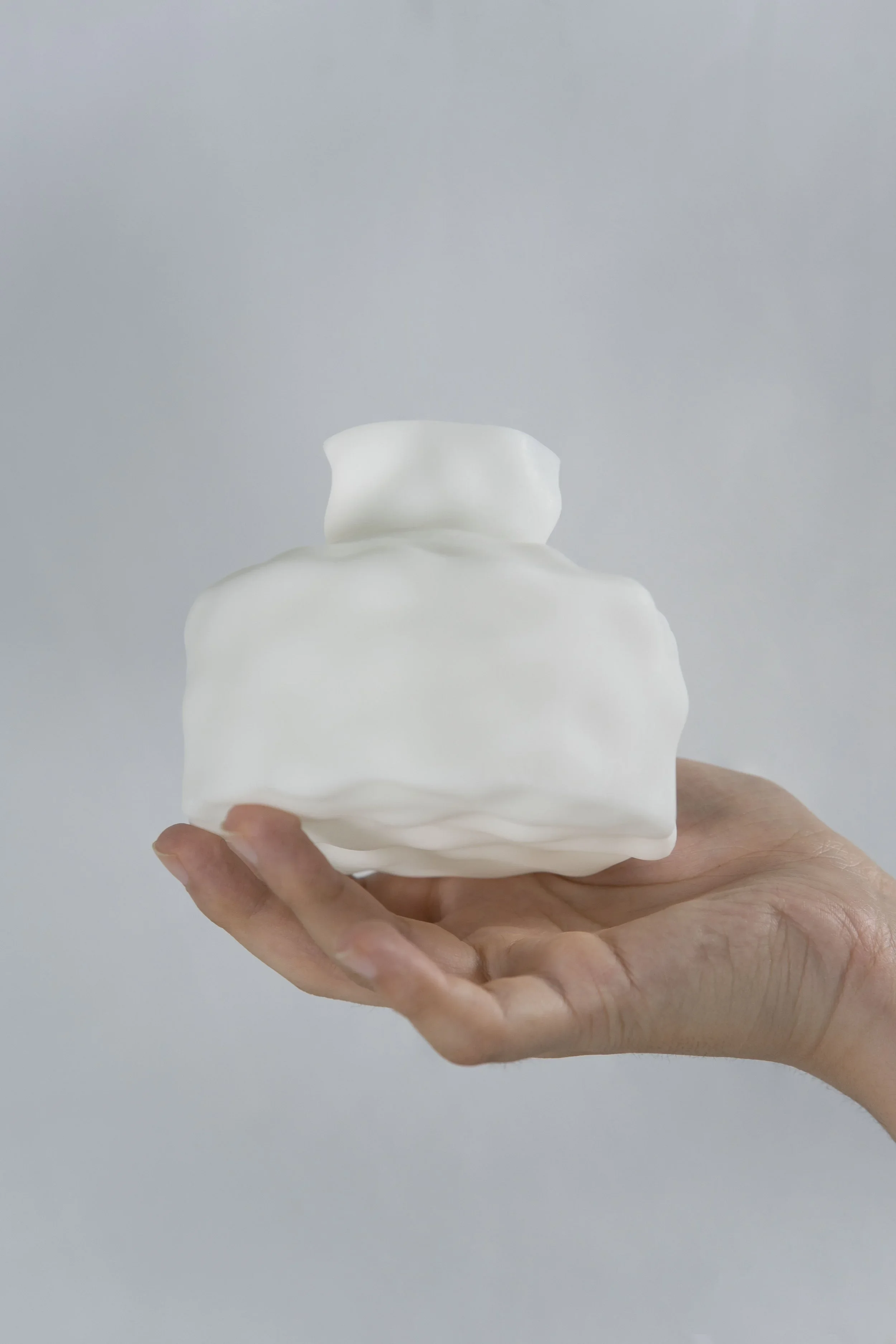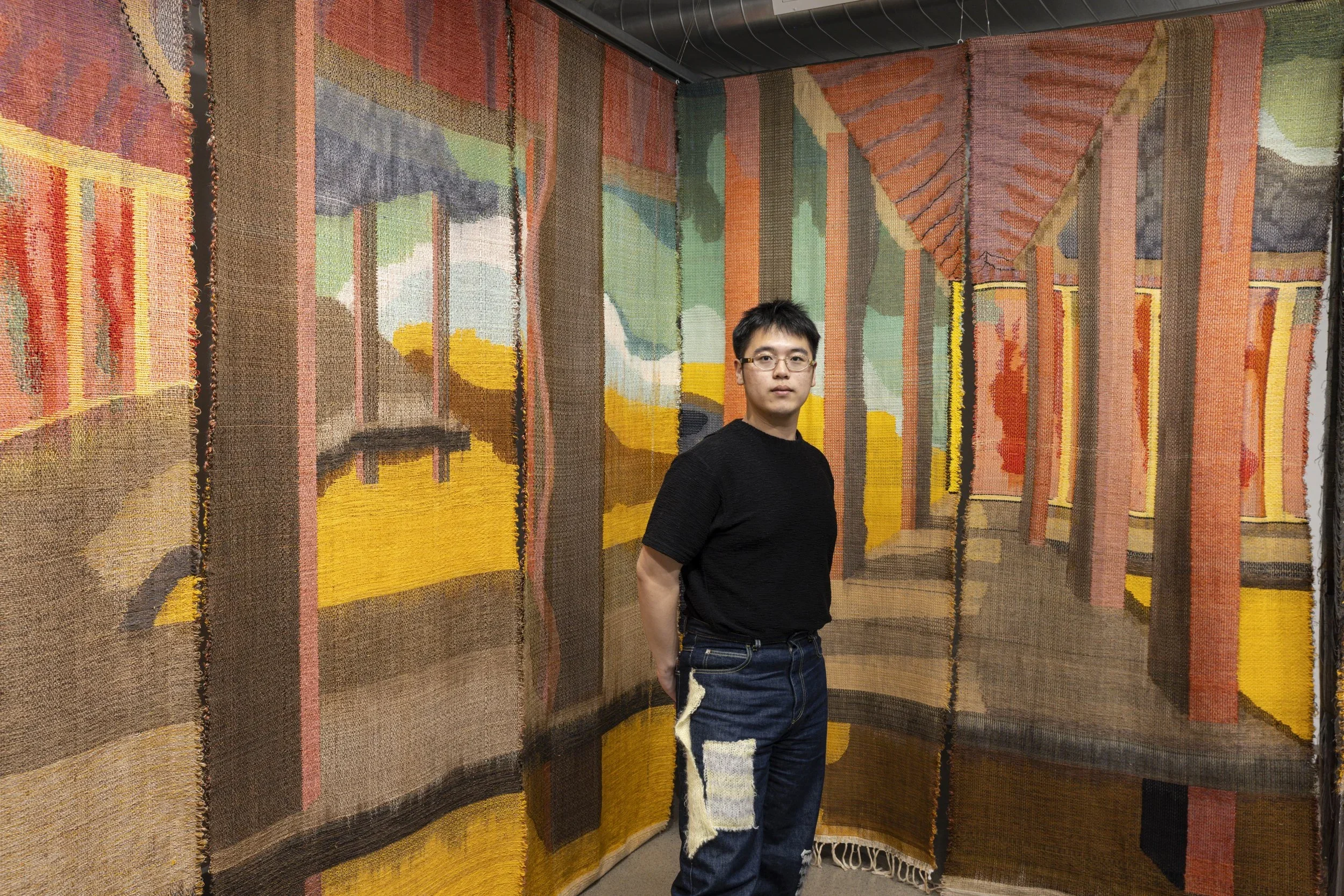10 Questions with Zhuoyu Zhang
Zhuoyu Zhang (b. 2000) is a new media artist from Beijing, currently based in New York. Deeply informed by critical media theory and digital poetics, her practice navigates the entangled relationships between identity, control, and mediated perception in today’s media-saturated society. Working across video installation, interactive storytelling, and algorithmic systems, Zhang draws from internet subcultures, personal archives, and speculative fiction to construct intimate yet dissonant environments that reflect on surveillance, disembodiment, and affective labour within visual regimes shaped by data infrastructures.
Zhang holds a BFA in Visual Communication from the School of the Art Institute of Chicago and is currently pursuing an MFA in Design and Technology at Parsons School of Design. Her work explores how digital infrastructures script emotion, desire, and bodily agency through platform governance, predictive interfaces, and gamified behavioural loops. This inquiry has materialised through moving-image installations, critical publishing, and interdisciplinary experiments. In 2025, her work was featured in The Enfleshment at Grace Exhibition Space (New York), the digital residency Public Access Memories, and the online journal Digital America (Issue No. 25). Previous projects include Far Above the Starry Sky, which was screened and nominated at the China Golden Rooster and Hundred Flowers Film Festival (Xiamen, 2022), and installations presented in Quivering Bodies and Grand Rising at SAIC (Chicago, 2022). Her recent collaborations include a project with the German Aerospace Center and Köln International School of Design, developing an interactive installation to translate quantum concepts into an embodied, sensorial experience.
Zhuoyu Zhang - Portrait
ARTIST STATEMENT
At the core of Zhuoyu Zhang’s practice lies a question: how do interfaces, databases, and predictive engines choreograph the feeling body into legibility or disappearance within contemporary visual regimes? Working through manipulated images, fractured storytelling, and interactive systems, her work constructs speculative media architectures that examine the illusion of choice in platform-governed life. By resisting linear interpretation, her work invites viewers to encounter how perception, emotion, and selfhood are subtly shaped by algorithmic infrastructures.
Across moving-image installations, interactive simulations, and algorithmic compositions, Zhang’s projects examine how bodies are rendered legible, abstracted, or erased under digital scrutiny, moving across a broad range of affective architectures, from the commodification of hyperfeminine aesthetics in pop culture, to the fragmentation of diasporic memory across online platforms to the gamified feedback systems embedded in everyday digital routines. Whether tracing familial intimacy, simulating data-driven decisions, or subverting contemporary portrayals of the reproductive body and its pathologisation, her works construct layered, often unsettling encounters that ask how agency is felt, filtered, and enacted.
Rather than seeking resolution, Zhang’s work reconfigures it as disruption. Aesthetics become operational, staging soft resistance against optimisation, legibility, and the slow violence of interface culture.
The Idol, Video Installation, 61.8 × 45 x 27.6 in, 2023 © Zhuoyu Zhang
INTERVIEW
Please tell us about your journey into art and what led you to focus on new media.
I've always seen art as a genuine form of expression, almost like a quiet calling. When I was younger, I started with traditional mediums like drawing and painting. In college, I studied visual communication and worked primarily with print design. But as digital platforms and streaming media became increasingly prominent in my life, I found myself intuitively translating daily exposure to visual and sonic language into new media practices. It didn't happen all at once, but the shift felt natural.
You work with video, interactive storytelling, and digital environments. What draws you to these mediums?
I began working seriously with video and interactive storytelling about two years ago. Before that, I had no experience creating moving image work beyond casual video editing. Encouraged by a professor, I took the leap, and surprisingly, everything clicked. I think this came from years of subconscious input and, as someone from Gen Z, growing up in a hyper-digital environment. That immersion gave me a generational advantage in navigating these mediums.
The Idol, Video Installation, Barbie Dreamhouse, 4 Raspberry Pi screens, various assemblage units, moving image © Zhuoyu Zhang
The Idol is a video installation embedded within a Barbie Dreamhouse model, examining how algorithmic systems, fandom labor, and global market pressures converge to construct femininity as a commodified spectacle. Using looping K-pop performance footage, AI-generated idol faces, and a disembodied Q&A soundscape, the work dissects how female idols are manufactured to oscillate between purity and desire, molded not by personal agency but by engagement metrics and industry aesthetics.
How does your background in visual communication influence your current artistic practice?
Even now, in many of my moving image or interactive works, I still rely heavily on graphic design techniques. For example, I'm drawn to glitch aesthetics, colour halftones, ASCII art, and other forms of visual noise. Having a strong foundation in visual communication gives me confidence when constructing visuals. No matter how experimental the work becomes, I still need a solid visual language to express what I want to say. For me, graphic design isn't something I left behind but something that continues to shape how I build and communicate images.
Can you share an example of a project where you made invisible digital structures perceptible to the audience?
In my visual novel Opt-Out.IO, I employed a "string of pearls" narrative structure, a format that appears open and nonlinear, yet remains fundamentally constrained. Between major plot nodes, players encounter micro-choices, optional detours, and narrative dead ends. On the surface, these branches suggest freedom. But in truth, all paths inevitably lead back to the main storyline. This is not a design flaw; it is an intentional metaphor. The structure mirrors how algorithmic platforms operate in real life. While they simulate choice and personalisation, they often funnel users toward predetermined behaviours, shaped by engagement metrics and opaque optimisation systems. I wanted players to feel that tension, the subtle frustration of believing they are making meaningful decisions, only to realise those decisions were never entirely theirs. Through this illusion of freedom, Opt-Out.IO invites audiences to reflect on how digital infrastructures choreograph not just our actions, but our emotions, routines, and sense of control. The piece makes these invisible constraints perceptible by embedding them into the very mechanics of play.
Where do you usually find inspiration for your projects?
I often find inspiration in the most overlooked moments of everyday life, things that feel guaranteed but rarely questioned. There's so much embedded in our daily routines that we've been trained not to notice. Giving up the urge to unpack how these black-box systems operate might make life easier, but it also means giving up our right to understand, to seek what lies beyond the visible tip of the iceberg. Another important part of my process is engaging with academic texts or journal articles. Sometimes, reading theory helps me make sense of past experiences, emotions, or recurring patterns. It's like discovering that something I once felt or witnessed actually has a name, a framework, or a systemic logic behind it. Those "aha" moments are really essential. I think we all carry hidden gemstones within us, it's just a matter of teasing out the relationships between those lived experiences and larger concepts.
Dolma, Video Installation, Foam mat, inflatable child seats, wooden cabinet, Mixed media collage, stainless wire, fishing wire, acrylic, cardboard, pigment, glass beads, pompom balls, elastic thread, print elements, moving image, 67.72 x 34.25.cm, 2023 © Zhuoyu Zhang
Dolma is a multimedia installation that weaves together personal narrative and digital ephemera to explore diasporic dislocation, digital memory, and the construction of selfhood in a mediated age. Drawing from Zhang’s lived experience, the work builds an intimate, diaristic archive from fragments of her upbringing: childhood toys, family voicemails, Windows XP-style UI, and analog photo scans.
How do you navigate personal narrative and systemic critique in your process?
I hope my work can offer moments of organic intellectual takeaway. Much like how I critique platform-mediated structures, I try not to reproduce the same patterns within my own storytelling methods. When working with personal narratives, I don't see storytelling as a linear delivery of meaning, but more like an open conversation with the audience. Throughout the process, I consulted many voices, gathered references, and struggled to strike a balance between emotional intensity and intellectual clarity. I often worried that certain narrative branches or character archetypes might alienate or mislead different players. But eventually, I came to realise that my role is not to dictate meaning. It is to be honest in how I tell the story, and to trust the audience to interpret it through their own lens. This is why I often embrace fragmented, nonlinear, and open-ended structures. It's not just an aesthetic decision; it is also a political one. In a time when algorithmic systems are increasingly scripting human behavior into predictable loops, ambiguity and multiplicity become subtle tools of resistance. My work doesn't aim to deliver closure or fixed truths. It offers a space of choice, to resist, to reframe, or to remain. And that space, to me, holds the most potential.
What is your creative process like when starting a new project?
I usually start by diving into a question or phenomenon that interests me, breaking it down to understand the underlying logic and related theories. Once I have a fair grasp of the topic, I try to assert my position or pose a question of my own.At the same time, I look into how other artists have approached similar themes, both in terms of format and conceptual framing. I also begin paying closer attention to my own life, looking for potential sparks in everyday moments. During this accumulation phase, I often experience sudden flashes of inspiration, which I quickly jot down in my notes. From there, I consider what formats might suit the concept based on my current skills and resources. Usually, once I reach that point, the vision of the final work starts flowing in. The next step is to hold on to that initial impulse and to stay connected to that early excitement and sense of possibility as I begin the actual making process.
Fetus in Fetus, Video Installation, Gynaecological examination bed, dual Raspberry Pi screens, moving image, 66.5 x 22 x 27.8 in, 2023 © Zhuoyu Zhang
Fetus in Fetus is a multi-channel video installation staged within a dimly lit clinical environment. At its center sits a sculptural apparatus modeled after a gynecological exam chair. Drawing from the artist’s personal experience with a teratoma, the installation reflects on how pathology is discursively coded and culturally projected onto female bodies. Medical narratives, archival images, and surgical aesthetics converge to construct the female patient as unstable, excessive, and contaminating. The tumor becomes not only a biological anomaly but also a metaphorical container for social anxieties around reproduction, purity, and death.
How do you design nonlinear or interactive storytelling experiences to evoke specific affective responses?
Although nonlinear narratives can seem complex, our generation is used to processing scattered inputs. I often include consistent narrative anchors to create emotional cohesion. For instance, in Opt-Out.IO, the smartphone acts as both a plot device and an affective signal. In Dolma, a looping Windows screensaver becomes a metaphor for shifting selfhood. These motifs allow me to bring coherence to even the most fragmented narratives. Another technique I rely on is emotional scaffolding through fragmented scene construction. Rather than telling the viewer what to feel, I create spaces that encourage active interpretation and emotional projection. The audience becomes part of the decoding process, tracing clues, following alternate paths, and gradually constructing their own understanding of the story world. Because each person interacts differently, interprets scenes through their own lived experiences, and draws unique associations, the emotional takeaways become plural. This divergence also opens up a second layer of dialogue between viewers about what the story meant to them.
Does working with technology change the way people connect with your art?
Absolutely. I believe working with technology has fundamentally changed the way people connect with my work, especially in terms of time, space, and the level of commitment involved in experiencing art. In traditional forms like theatre, opera, or cinema, the audience participates through a clear dispositif: buying a ticket in advance, showing up on time, sitting in a dark room for hours, and sharing the experience with strangers. This structure is not just formal; it is deeply entangled with systems of labour, logistics, authorship, and capital. It conditions how we watch, how we pay attention, and how meaning is collectively shaped. Today, much of that infrastructure has been flattened or rendered invisible. Audiences now encounter my work through phones or laptops, often in passing, while commuting, in bed, or between tasks. This makes engagement more accessible but also more fragmented, unstable, and shaped by platform algorithms. Technology does not simply enable connection; it also introduces short-term logic and emotional disorientation. In The Idol, I directly address this shift in viewing structures. I created a manipulated Q&A interface using AI-generated dialogue juxtaposed with fragmented K-pop lyrics, many of which come from officially released songs that portray a polished and idealised image of female idols. By selectively editing these lyrics out of context, I expose how the industry fabricates a persona of authenticity. Just as the Q&A is assembled by me, the idol's media presence is also meticulously constructed by the entertainment system. The piece invites viewers to confront how narratives of femininity, perfection, and desirability are manufactured, consumed, and circulated in platform-mediated environments. Rather than expecting full or linear engagement, I design my work to allow for partial attention, asynchronous entry, and fragmented reception. I am interested in how emotional resonance can still emerge through delay, repetition, and ambiguity, how a moment of discomfort or confusion might linger long after the screen is closed.
Opt-Out.IO, Interactive Visual Novel Game, Variable Dimensions, 2025 © Zhuoyu Zhang
Opt-Out.IO is an interactive visual novel that explores the illusion of choice in our algorithmically-governed lives. Set in an eerie yet familiar environment, players awaken as an amnesiac student guided by a seemingly helpful but mysterious figure. But behind every action you make, the unseen force is watching, learning, and narrowing the path forward. Opt-Out.IO questions how platforms turn users into predictable datasets under the guise of personalization.
Opt-Out.IO, Interactive Visual Novel Game, Variable Dimensions, 2025 © Zhuoyu Zhang
Are there any upcoming projects or themes you're excited to explore in the near future?
I'm interested in exploring the relationship between gender, horror culture, and media structures. Contemporary horror often recasts women as monsters rather than victims. I'm curious whether this shift signifies reclaimed power or just a stylised repackaging of fear. This continues my exploration of maternal uncanniness, which I began in Fetus in Fetus, while also delving into affective narrative structures. Through experimental storytelling, I want to ask: Does horror offer new agency, or simply reframe old anxieties? I think it's a question worth asking again and again.
Artist’s Talk
Al-Tiba9 Interviews is a curated promotional platform that offers artists the opportunity to articulate their vision and engage with our diverse international readership through insightful, published dialogues. Conducted by Mohamed Benhadj, founder and curator of Al-Tiba9, these interviews spotlight the artists’ creative journeys and introduce their work to the global contemporary art scene.
Through our extensive network of museums, galleries, art professionals, collectors, and art enthusiasts worldwide, Al-Tiba9 Interviews provides a meaningful stage for artists to expand their reach and strengthen their presence in the international art discourse.






















